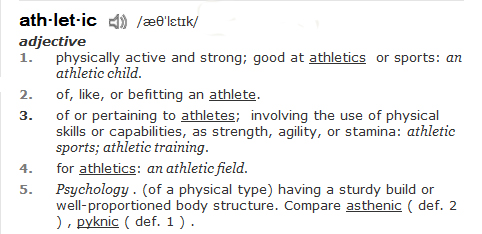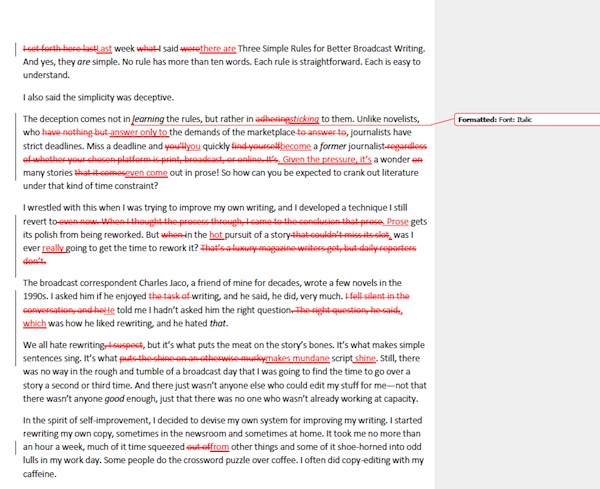A friend asked me the other day what makes good broadcast writing. I told him there are only three rules:
- No sentence should have more than 20 words
- Write in the active rather than the passive voice
- Write to the picture
I was happy I could reduce a skill it took me an adult lifetime to become proficient at to three phrases (each under ten words).
The 20-Word Limit
Broadcast writing, as better practitioners of it than I have pointed out repeatedly, is for the ear, not the eye. The audience never gets to see the words as they would if the medium were text, so there’s no tracking back, no quick reviews. In broadcast, the words are there, and then they’re not.
To make sure it’s understood means stripping a sentence to its basics. Commas—tell-tale signs of clauses and appended phrases—are warning signals. They’re telling you there’s more than a single idea at work. If you see commas, it’s time to rework the sentence to get rid of them. Ted Feurey, a news legend I was lucky enough to have as a teacher and mentor, told his students that if they couldn’t express a single thought in under 20 words, they needed to think about selling shoes for a living. (Ted was nothing if not brutally honest!)
The 20-word limit doesn’t apply to text, where a dependent clause or a prepositional phrase can make for a nice flourish. Because of that, much of the writing we all started learning with wide-ruled paper and thick pencils has to be unlearned. At the very least, it needs to be sent to the corner. Broadcast writing doesn’t read very well in the text world. It appears choppy and incomplete. But again, it’s not meant for the eye. It’s meant for the ear, and it works very well in that medium.
Passive Voice and the Backwards Sentence
The Passive Voice forces sentences to move in the wrong direction. Our ears are attuned to a consistent flow in English that moves forward. It goes from Actor to Action to Acted Upon. In an Active Voice sentence, those things are called Subject, Verb, and Object. Let me give you an example:
The boy hit the ball.
“The boy” is the actor. “Hit” is the action. “The ball” is the acted upon.
If we change the sentence to the passive voice, we can see how it gets turned around:
The ball was hit by the boy.
In this sentence, “ball” is the subject, “was hit” the verb, and “boy” a prepositional phrase that modifies the verb and also is the object. Subject-verb-object remain in the right order, but Actor-Action-Acted Upon is turned around. It has become Acted Upon-Action-Actor.
That combination is awkward, because it forces us to pick the parts of the sentence, commit them to memory, and then reorder them after we hear the whole thing to the simple pattern we were expecting. It’s also awkward because the passive voice takes more words—the verb requires an auxiliary verb (some form of “to be” and the subject requires a preposition (“by,” in this case) to explain the relationship of the Actor to the Action.
That makes the sentence a lot of work. When a listener is asked to do a lot of work, he or she quickly becomes a non-listener. Talk about backwards motion!
There are some ancient grammar lessons rolling around inside all of us that can cloud this rule. Think back to what in my day was called junior high school and is now known as middle school. Whatever the name, we all know it as the time we were forced to diagram sentences.
Voice is not the same thing as tense. Tense tells us when something happened—past, present, or future. Watch how it changes all within the active voice:
- The boy hit the ball. (past)
- The boy hits the ball. (present)
- The boy will hit the ball. (future)
Voice is a grammatical indication of transformation—the active voice tells us who made the transformation, the passive voice only that a transformation has happened.
In our active-voice example, “The boy hit the ball,” we know from the start who turned the ball from an un-hit state to a hit one. It was “the boy.” In a truncated version of our passive-voice example, “The ball was hit,” we have no idea who made the transformation, just that it somehow happened.
Writing to the Picture
This is how the rule is often stated, but I think it’s a very bad way of doing it. It’s hard to understand. What it means is that you need to explain what the viewer is looking at before you explain why the viewer is looking at it. The writing coach Mackie Morris, who spent years making the rounds of TV newsrooms, stated the rule as “Touch and Go.” Fewer words, to be sure, but it still doesn’t make the point for someone who doesn’t already get the point.
Here’s an example of how it works. Decades ago, in a documentary for affiliates about how CBS News works, Correspondent Charles Kuralt—a wordsmith of the first order—opened with a close-up shot of a watch. His opening words were, “It’s a gold Tiffany watch. They give you one of these when you’ve been at CBS for 20 years. I got mine last year.”
What Kuralt needed to say was that he’d been there for two decades. But first he needed to explain the shot. He needed to let viewers know what they were looking at. He did it in five words. Then he needed to explain why it was significant. He “wrote to the picture,” first saying what was on the screen and then explaining why. He “touched” the picture, and then “went” on. Touch and go!
This, again, is an easy rule to remember, but a hard one to put into practice. We had drilled into us in that same lifetime of writing that started with one-inch lines that we needed to start with a topic sentence and then bolster it with facts. Well, in text, that’s still a good way to do it. But it doesn’t work as well when we’re writing for the ear instead of the eye. This is established principle in logic, where it’s known as “inference from the lesser to the greater.”
The reason this is essential in broadcast writing is that seeing a watch on the screen and hearing Kuralt say he’s been at CBS News for 20 years is a sensory disconnect. The image doesn’t match the words. When the two collide, the viewer’s mind tries to process it and, not being able to, stops trying. The result is a viewer on his or her way to something else.
So those are the three rules. They may look simple, but that’s really an illusion. It’s hard work to make writing look easy. In future posts, I’ll provide some ideas on things you can do to start improving how you say what you say.
Originally published on August 7, 2011 at HalEisner.com.
 to state labs for genetic testing that can reveal a wide range of diseases that need immediate treatment.
to state labs for genetic testing that can reveal a wide range of diseases that need immediate treatment.







